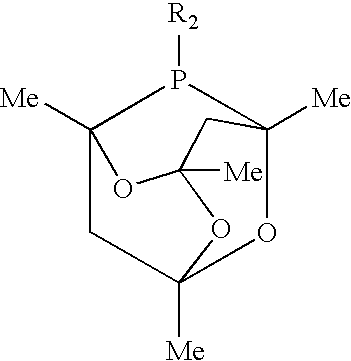Process of Preparing Glycolaldehyde
a glycolaldehyde and process technology, applied in the field of preparing glycolaldehyde, can solve the problems of lowering the yield of glycolaldehyde, lessening the effectiveness of glycolaldehyde, and reducing the conversion and selectivity of glycolaldehyd
- Summary
- Abstract
- Description
- Claims
- Application Information
AI Technical Summary
Benefits of technology
Problems solved by technology
Method used
Image
Examples
example 1
(“2-PA”-C20 Ligand in Non-Aqueous Conditions)
[0047]The autoclave was charged with 0.17 mol of formaldehyde, in the form of para-formaldehyde, 62 ml (0.58 mol) of N-methyl-pyrrolidone, 0.25 mmol of rhodiumdicarbonylacetonylacetone (Rh(acac)(CO)2), 0.50 mmol of 2-phospha-2-icosyl-1,3,5,7-tetramethyl-6,9,10-trioxa-tricyclo[3.3.1.1{3,7}]-decane, and 9.1 mmol of trimethylbenzoic acid. The contents of the autoclave were then heated to a temperature of 110° C. and maintained at that temperature for 2 hours.
[0048]Conversion of formaldehyde was 100% and the yield of glycolaldehyde, calculated on formaldehyde intake, was 76%. The initial reaction rate was calculated by measurement of the pressure drop to be 595 mol CO / mol Rh.h.
example 2
(“2-PA”—C20 Ligand in Aqueous Conditions)
[0049]The autoclave was charged with 0.17 mol of formaldehyde, in the form of para-formaldehyde, 35 ml (0.22 mol) of dibutyl-acetamide, 25 ml of demineralised water, 0.25 mmol of Rh(acac) (CO)2, 0.53 mmol of 2-phospha-2-icosyl-1,3,5,7-tetramethyl-6,9,10-trioxa-tricyclo[3.3.1.1{3,7}]-decane, and 9.1 mmol of trimethylbenzoic acid. The contents of the autoclave were heated to a temperature of 110° C. and maintained at that temperature for 5 hours.
[0050]Conversion of formaldehyde was 64% and the yield of glycolaldehyde in the two-phase reaction product, calculated on formaldehyde intake, was 45%. The initial reaction rate was calculated by measurement of the pressure drop to be 115 mol CO / mol Rh.h
example 3
(“2-PA”—CH2CH2C(O)NMe2 Ligand in Non-Aqueous Conditions)
[0051]The autoclave was charged with 0.18 mol of formaldehyde, in the form of para-formaldehyde, 23 ml (0.15 mol) of di-sec-butyl-acetamide, 0.25 mmol of Rh(acac)(CO)2, 0.49 mmol of 2-phospha-2-(ethyl-N,N-dimethylamido)-1,3,5,7-tetramethyl-6,9,10-trioxa-tricyclo[3.3.1.1{3,7}]-decane, and 9.1 mmol of trimethylbenzoic acid. The contents of the autoclave were then heated to a temperature of 100° C. and maintained at that temperature for 3 hours.
[0052]Conversion of formaldehyde was 72% and the yield of glycolaldehyde in the single-phase reaction product, calculated on formaldehyde intake, was 69%. The initial reaction rate was calculated by measurement of the pressure drop to be 275 mol CO / mol Rh.h.
PUM
 Login to View More
Login to View More Abstract
Description
Claims
Application Information
 Login to View More
Login to View More - R&D
- Intellectual Property
- Life Sciences
- Materials
- Tech Scout
- Unparalleled Data Quality
- Higher Quality Content
- 60% Fewer Hallucinations
Browse by: Latest US Patents, China's latest patents, Technical Efficacy Thesaurus, Application Domain, Technology Topic, Popular Technical Reports.
© 2025 PatSnap. All rights reserved.Legal|Privacy policy|Modern Slavery Act Transparency Statement|Sitemap|About US| Contact US: help@patsnap.com

